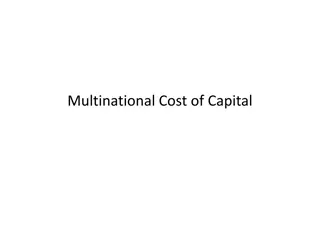Understanding Multinational Capital Budgeting Process
Multinational capital budgeting involves evaluating international projects by analyzing future cash flows, net present value, and initial investment outlay. Factors like exchange rate fluctuations, inflation, and financing arrangements need careful consideration. Proper use of this process helps identify viable projects and impacts a firm's profitability and long-term cost structure.
- Capital budgeting
- Multinational corporations
- Investment analysis
- International projects
- Financial management
Download Presentation

Please find below an Image/Link to download the presentation.
The content on the website is provided AS IS for your information and personal use only. It may not be sold, licensed, or shared on other websites without obtaining consent from the author. Download presentation by click this link. If you encounter any issues during the download, it is possible that the publisher has removed the file from their server.
E N D
Presentation Transcript
Capital Budgeting Capital Budgeting may be defined as the decision making process by which firms evaluate the purchase of major fixed assets including premises, machinery and equipment. Capital budgeting is the process of identifying, evaluating, and implementing a firm s investment opportunities
Multinational capital budgeting like traditional domestic capital budgeting, focuses on the cash inflows and outflows associated with prospective long-term projects. Multinational capital budgeting has the same theoretical framework as domestic capital budgeting (foreign) investment
Multinational capital budgeting Multinational corporations (MNCs) evaluate international projects by using multinational capital budgeting, which compares the benefits and Multinational capital budgeting involves determining the project s net present value by estimating the present value of the project s future cash flows and subtracting the initial outlay required for the projects. Some special circumstances of international projects that affect the future cash flow or the discount rate used to discount cash flow make multinational capital budgeting more complex costs of these projects.
Multinational capital budgeting Analysis involves estimating annual cash flows and salvage value to be received by the parent, and then computing the net present value (NPV) of the project. Capital budgeting is necessary for all longterm projects that deserve consideration.
Why Multinational capital budgeting Many international projects are irreversible and cannot be easily sold to other corporations at a reasonable price Proper use of multinational capital budgeting can identify the international projects worthy of implementation. It affects the profitability of a firm. It effect over a long time spans and inevitably affects the company s future cost structure. Capital investment decision once made, are not easily reversible without much financial loss of firm It involves cost and the majority of the firms have scarce capital sources.
Factors to Consider in Multinational Capital Budgeting Exchange rate fluctuations. Different scenarios should be considered together with their probability of occurrence. Inflation. Although price/cost forecasting implicitly considers inflation, inflation can be quite volatile from year to year for some countries. Financing arrangement. Financing costs are usually captured by the discount rate. However, many foreign projects are partially financed by foreign subsidiaries. Blocked funds. Some countries may require that the earnings be reinvested locally for a certain period of time before they can be remitted to the parent.
Factors to Consider in Multinational Capital Budgeting Uncertain salvage value. The salvage value typically has a significant impact on the project s NPV, and the MNC may want to compute the break-even salvage value. Impact of project on prevailing cash flows. The new investment may compete with the existing business for the same customers. Host government incentives. These should also be considered in the analysis.
Input for Multinational Capital Budgeting 1. 2. 3. 4. 5. 6. 7. 8. 9. 10. Exchange rates 11. Required rate of return Initial investment Consumer demand Product price Variable cost Fixed cost Project lifetime Salvage (liquidation) value Fund-transfer restrictions Tax laws
Multinational capital budgeting Capital budgeting for multinational firms uses the same framework as domestic capital budgeting. However, multinational firms engaged in evaluating foreign projects face a number of complexities, many of which are not there in the domestic capital budgeting process.
Foreign Complexities Multinational capital budgeting encounters a number of variables and factors that are unique for a foreign project and are considerably more complex than their domestic counterparts. The various factors are: 1. Parents cash flows are different from project cash flows. 2. All cash flows from the foreign projects must be converted into the currency of the parent firm. 3. Profits remitted to the parent are subject to two taxing jurisdictions the parent country and the host country.
Foreign Complexities 4. Anticipate the differences in the rates of national inflation as they can result in changes in competitive position and thus in cash flows over a period of time. 5. The possibility of foreign exchange risk and its effect on the parent s cash flows. 6. If the host country provides some concessionary financing arrangements and/or other benefits, the profitability of the foreign project may go up.
Foreign Complexities 7. Initial investment in the host country may benefit from a partial or total release of blocked funds. 8. The host country may impose various restrictions on the distribution of cash flows generated from foreign projects. 9. Political risk must be evaluated thoroughly as changes in political events can drastically reduce the availability of expected cash flows. 10. It is more difficult to estimate the terminal value in multinational capital budgeting because potential buyers in the host or parent company may have widely different views on the value to them of acquiring the project.
Foreign Exchange Risk Multinational firms investing abroad are exposed to foreign exchange risk the risk that the currency will appreciate or depreciate over a period of time. Understanding of foreign exchange risk is important in the evaluation of cash flows generated by the project over its life cycle. To incorporate the foreign exchange risk in the cash flow estimates of the project, first an estimate is made of the inflation rate in the host country during the life span of the project. The cash flows, in terms of local currency, are then adjusted upwards for the inflation factor. Then the cash flow are converted into the parent s currency at the spot exchange rate multiplied by an expected depreciation or appreciation rate calculated on the basis of purchasing power parity. In certain specific situations, the conversion can also be made on the basis of some exchange rate accepted by the management.
Remittance Restrictions Where there are restrictions on the repatriation of income, substantial differences exist between project cash flows and cash flows received by the parent firm. Only those flows that are remittable to the parent are relevant from the MNC s perspective. Many countries impose a variety of restrictions on transfer of profits, depreciation and other fees accruing to the parent company. Project cash flows consist of profits and depreciation charges whereas parent s cash flows consist of the amounts that can be legally transferred by the affiliate.
Remittance Restrictions In cases where the remittances are legally limited, the restrictions can be circumvented to some extent by using techniques like internal transfer prices, overhead payments, and so on. To obtain a conservative estimate of the contribution by the project, the financial manager can include only the income which is remittable via legal and open channels. If this value is positive no more additions are made. If it is negative, we can add income that is remittable via other methods (not necessarily legal). Another adjustment in multinational capital budgeting is the problem of Blocked Funds. Accounting for blocked funds in the capital budgeting process depends on the opportunity cost of blocked funds.
Tax Issue Both in domestic and multinational capital budgeting, only after-tax cash flows are relevant for project evaluation. However, in multinational capital budgeting, the tax issue is complicated by the existence of two taxing jurisdictions, plus a number of other factors. The other factors include the form of remittance to the parent dividends management fees, royalties, etc., tax withholding provision in the host country, existence of tax treaties, etc. In addition, tax laws in many host countries discriminate between transfer of realised profits as against local reinvestment of these profits. The ability of the multinational firm to reduce its overall tax burden through the transfer pricing mechanism should also be considered.
Tax Issue To calculate the actual after-tax cash flows accruing to the parent the higher of the home or host country tax rate can be used. This will represent a conservative scenario in the sense that if the project proves acceptable under this alternative then it will necessarily be acceptable under the more favourable tax scenario. If not, other tax saving may be incorporated in the calculation to determine whether or not the project crosses the hurdle rate.
Project versus Parent Cash Flows Substantial differences can exist between the project and parent cash flows because of tax regulations and exchange controls. Also, management fees and royalties are returns to the parent company. In the light of substantial differences that can exist between parent and project cash flows, the important question is on what basis should the project be evaluated. Should the project be evaluated on the basis of 1. Its own cash flows? 2. Cash flows accruing to the parent company? 3. Both? expenses such as
Project versus Parent Cash Flows Evaluating a project on the basis of its own cash flows serves some useful purposes. The project must be able to compete successfully with other domestic firms and also earn a rate of return in excess of its locally based competitors. If not, the management and the shareholders of the parent company would be better off investing in the equity/government bonds of local firms.
Project versus Parent Cash Flows However, such a comparison is many times not possible because most foreign projects replace imports and generally do not compete with existing local firms. Yet, evaluating projects on the basis of local cash flows has the advantage of avoiding currency conversion and hence eliminating problems involved with fluctuating/forecasting exchange rates changes for the life of the project.
Project versus Parent Cash Flows A strong theoretically valid criterion in financial management is to evaluate the foreign project from the viewpoint of the parent company. Cash flows which are actually remitted to the parent are the ultimate yardstick for company performance and form the basis for distribution of dividends to the shareholders, repayment of interest and debt to lenders and other purposes. This helps in determining the financial viability of the project from the viewpoint of the MNC as a whole. The cash flows that are remitted to the parent consist of both operating cash flows and financial cash flows like fees and royalties, interest on loans given by the parent. However, the theory of capital budgeting postulates that an investment should be evaluated only on the basis of net after-tax operating cash flows generated by the project. Since these flows are usually lumped together, care should be taken that financial cash flows are not mixed with operating cash flows.
Project versus Parent Cash Flows Stonehill and Nathanson have suggested a three-stage financial analysis of foreign projects. In the first stage, project cash flows are computed and analysed from the viewpoint of the subsidiary or the affiliate as if it were a separate entity. The second stage involves evaluation of the profit on the basis of forecasts of cash flows which will be transferable to the parent company. In the third and last stage, the analysis from the viewpoint of the parent company is widened to include indirect benefits or costs from the company as a whole, which are attributable to the foreign project in question.
Various surveys conducted over a period of time show that MNCs evaluate foreign projects from both the parent s and the project s viewpoints. Surveys conducted by Stonehill and Nathanson (1968), Baker and Beandsley (1973), Oblak and Helm (1980), Bavishi (1981), Stanley and Block (1983) reveal that firms calculate and evaluate rates of returns by using cash flows to and from the parent as well as to and from foreign project alone.
Thus, most firms generally evaluate foreign projects from both parent and project viewpoints. Evaluating and analysing cash flows from both viewpoints reveals important aspects about the project s competitiveness and its contribution to the company as a whole. The project viewpoint provides a closer approximation of the effect on consolidated earnings per share, which all surveys mention is of major concern to practising managers. The parent s viewpoint gives results closer to the traditional meaning of net present value in capital budgeting.
Techniques of Capital Budgeting The investment decisions is known as the capital budgeting or capital expenditure decision. This decision is one of the critical decisions faced by the finance managers and is crucial to the success of a company. Companies devote significant time and effort in planning capital budgeting decisions because a company that makes a mistake in its capital budgeting process has to live with that mistake for a long time. Two popularly used discounted cash flow techniques of capital budgeting are the Net Present Value (NPV) and Internal Rate of Return (IRR). process of evaluating specific long-term
Net Present Value The NPV method explicitly recognizes the time value of money. Companies use the NPV method when they have to decide whether to continue with the existing equipment or buy new equipment that would increase production efficiency. The NPV method is important because it expresses in absolute terms the benefit of the project to the shareholders. NPV is the most popular method and is defined as the present value of future cash flows discounted at an appropriate rate minus the initial net cash outlay for the projects. The discount rate used here is known as the cost of capital. The decision criteria
Net Present Value To implement the NPV method you need: 1. To calculate the present value of the expected cash inflows and outflows discounted at the project s cost-of-capital rate. 2. To subtract the present value of the cash inflows from the present value of the initial net cash outflows to calculate the NPV of the project. 3. If the NPV of a project is positive, accept the project; if not reject the project.
Net Present Value The accept-reject criterion can be specified as: NPV > 0 > Finance manager accepts the investments NPV < 0 > Finance manager rejects the investments NPV = 0 >Finance manager is indifferent toward acceptance or rejection of the project
Internal Rate of Return The IRR method is a discounted cash-flow technique. Similar to the NPV method, it takes into account the magnitude and timing of cash flows. IRR is defined as the discount rate that equates the present value of expected future cash inflows with the present value of the project s initial cash outflows. Various empirical surveys have shown that companies prefer the IRR method because it is a relative measure of the projects worth.
In the IRR method, you calculate the discount rate to make the NPV of the project zero. This means that in the IRR method, you equalize the net cash proceeds over a project s life with the initial investment outlay. The IRR for a project is then compared with the hurdle rate, which is the company s market-determined required rate of return. If the IRR exceeds the cost-of-capital rate the project is accepted, otherwise it is rejected. The IRR calculation is generally a trial-and-error exercise because the rate is unknown.
The accept-reject for the IRR criterion can be specified as: If IRR > k Accept the project If IRR < k Reject the project If IRR = k Indifferent between acceptance and rejection of the proposal.
Adjustment for Risk: Cash Flows versus Discount Rate Adjustment
Another important dimension in multinational capital budgeting is whether to adjust cash flows or the discount rate to account for the additional risk that arises from the foreign location of the project. Traditionally, MNCs have adjusted the discount rate by moving it upwards for riskier projects to reflect the political and foreign exchange uncertainties. A significant number of firms that use the DCF technique in domestic projects also assign different hurdle rates for different projects, depending on their risk categories. Adjusting the discount rate is quite a popular method with MNCs mainly because of its simplicity and the rule that the required rate of return of a project should be in accordance with the degree of risk which it is exposed to.
Adjusting the discount rate for political risk thus penalises early cash flows too heavily while not penalising distant cash flows enough. As far as the foreign exchange risk is concerned, adjusting the discount rate to offset the exchange risk is an oversimplification. This is so because only adverse exchange rate movements are expected whereas it is entirely possible for a MNC to many times gain from favourable overall currency movements during the life of the project.
The other alternative is to adjust cash flows rather than the discount rate in treating risk. The annual cash flows are discounted using the applicable rate for that type of project either at the host country or at the parent country. Probability and certainty equivalent techniques like decision tree analysis are used in economic and financial forecasting. Cash flows generated by the project and remitted to the parent during each time period are adjusted for political risk, exchange rate and other uncertainties by converting them into certainty equivalent. The method of adjusting the cash flows rather than the discount rate is generally the more popular method
and is usually recommended by finance managers. There is generally more information on the specific impact of a given risk on a project s cash flows than on its discount rate.
Financing Arrangement In some cases, the governments of countries are willing to provide loans at subsidized rates so as to stimulate investment in specific sectors. The value of a project will then be determined by the manner in which it is financed. For example, many times, international agencies in order to promote cross border trade finance at below market rates. In the case of subsidized financing, it is important to determine, if the subsidized financing is separable or not from the project. When the subsidized financing is inseparable from the project, the value of the loan should be added to that of the project in making the investment decision. When subsidized financing is separable from the project, the additional value from the subsidized financing should not be allocated to the project.
Blocked Funds Blocked Funds are cash flows generate by a foreign project that cannot be immediately transferred to the parent, usually because of exchange controls imposed by the government of the country in which the funds are held. Some countries require that the earnings generated by the subsidiary be reinvested locally for at least a certain period of time before they can be remitted to the parent. Blocked funds cause a discrepancy between the project value from the parent s and local perspective. Also, this can possibly affect the accept/reject decision for a project.
Inflation The impact of inflation on the parent s and subsidiary s cash flows can be quite volatile from year to year for some countries. It may cause the currency to weaken and hence influence a project s cash flows. Also, inaccurate inflation forecast by a country, can lead to inaccurate cash flow forecasts. Thus, MNCs cannot afford to ignore the impact of inflation on the cash flows.
Uncertain Salvage Value The salvage value of a project has an important impact on the NPV of the project. When the salvage value is uncertain, the cash flows will not be accurate and the MNC may need to calculate various possible outcomes for the salvage value and estimate the NPV based on each possible outcome. The feasibility of the project may then depend upon the present value of the salvage value.
Questions What are blocked finds? Elucidate with examples. Examine the impact of exchange rate movements on cash flows to the parent/to the subsidiary. Describe the various budgeting that are normally adopted by MNCs. What additional factors deserve consideration in multinational capital budgeting that are not normally relevant for a purely domestic project? Why should capital budgeting for subsidiary projects be assessed from the parent company s perspective? Give reasons. methods of capital
FUNDAMENTALS OF EVALUATING FOREIGN PROJECTS Once a firm has compiled a list of prospective investments, it uses capital budgeting techniques, to select from among them that combination of projects that maximizes the firm s value to shareholders. The theoretical framework involved in evaluation of domestic projects is the same as for foreign projects and various considerations influencing choice of a project within the country are the, same as those for projects overseas. However, there are a host of factors which are unique to foreign investments that make cross-border investment decisions complicated.
FUNDAMENTALS OF EVALUATING FOREIGN PROJECTS The basic steps involved in evaluation of a project are: 1. Determine net investment outlay; 2. Estimate net cash flows to be derived from the project over time, including an estimate of salvage value; 3. Identify the appropriate discount rate for determining the present value of the expected cash flows; 4. Apply NPV or IRR techniques to determine the acceptability or priority ranking of potential projects.
FUNDAMENTALS OF EVALUATING FOREIGN PROJECTS As stated earlier, the above evaluation process becomes complicated because of the factors peculiar to international operations. Some of the factors unique to capital budgeting for MNCs are:
FUNDAMENTALS OF EVALUATING FOREIGN PROJECTS 1. Conversion of cash flows from foreign projects into the currency of the parent firm; 2. Restrictions on full remittance of cash flows from foreign projects; 3. Exchange Rate fluctuations; 4. Application of different tax rates in the country of the project and in the parent's country; 5. Involvement of royalties and management fees;























